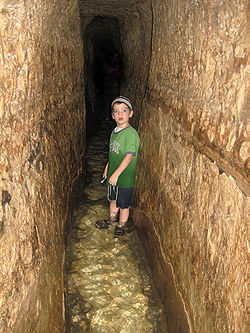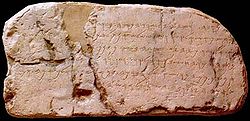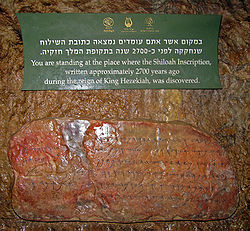- Hezekiah's Tunnel
-
Hezekiah's Tunnel, or the Siloam Tunnel (Hebrew: נִקְבַּת השילוח, Nikbat HaShiloah) is a tunnel that was dug underneath the City of David in Jerusalem before 701 BC during the reign of Hezekiah, in Israel. The tunnel is mentioned in 2 Kings 20:20 in the Bible. The Bible also tells us that King Hezekiah prepared Jerusalem for an impending siege by the Assyrians, by "blocking the source of the waters of the upper Gihon, and leading them straight down on the west to the City of David" (2 Chronicles 32). The tunnel has been securely dated both by the written inscription found on its wall (Siloam Inscription), and by dating organic matter contained in the original plastering.[1] It is one of the few intact, 8th century BC structures in the world that the public can not only visit, but enter and walk through.
The tunnel, leading from the Gihon Spring to the Pool of Siloam,[2][3][4] was designed as an aqueduct to provide Jerusalem with water during an impending siege by the Assyrians, led by Sennacherib. The curving tunnel is 533 m long, and by using a 30 cm (0.6‰) gradient altitude difference between each end, conveyed water along its length from the spring to the pool.
According to the Siloam inscription, the tunnel was excavated by two teams, one starting at each end of the tunnel and then meeting in the middle. The inscription is partly unreadable at present, and may originally have conveyed more information than this. It is clear from the tunnel itself that several directional errors were made during its construction.[5] Recent scholarship has discredited the idea that the tunnel may have been formed by substantially widening a pre-existing natural karst.[1]
The difficult feat of making two teams digging from opposite ends meet far underground is now understood to have been accomplished by directing the two teams from above using sounds generated by hammering on the solid karst through which the tunnelers were digging.[1]
Contents
Function and origin
The ancient city of Jerusalem, being on a mountain, is naturally defensible from almost all sides, but suffers from the drawback that its major source of fresh water, the Gihon spring, is on the side of the cliff overlooking the Kidron Valley. This presents a major military weakness as the city walls, if high enough to be defensible, must necessarily leave the Gihon spring outside, thus leaving the city without a fresh water supply in case of siege.
The Bible says that King Hezekiah (c. 8th century BC), fearful that the Assyrians would lay siege to the city, blocked the spring's water outside the city and diverted it through a channel into the then Pool of Siloam.[6] However, it is now known (as of 1997) that the earlier Warren's shaft system had already heavily fortified the Gihon Spring;[7] Warren's shaft is not an aqueduct, and requires those desiring water to travel up and down it themselves - an arrangement that Hezekiah seemingly must have considered inadequate.
In 1899, an ancient channel, also leading from the Gihon Spring to the Siloam Pool area, but by a more direct route, was found. This channel is now known as the Middle Bronze Age channel, on account of its estimated age. Ronny Reich determined that it was constructed around 1800 BC (in the Middle Bronze Age), and thus that the spring's water had already been diverted many centuries before Hezekiah. As originally constructed, it is understood as a 20 feet deep ditch in the ground, covered over by large rock slabs (which were then hidden in the foliage). It is narrower than the tunnel, but can still be walked by a human for most of its length. In addition to the (3 ft high) exit near the Siloam pool, the channel has several small outlets that watered the gardens facing the Kidron Valley.[8] Hezekiah's tunnel was constructed to replace this channel, since a besieging army could fairly easily have discovered and destroyed the Middle Bronze Age Channel.
Hezekiah's tunnel, discovered in 1838 by the American biblical scholar Edward Robinson, can be walked through today from end to end.
The Bible verses relating to Hezekiah's tunnel are these:
"And the rest of the acts of Hezekiah, and all his might, and how he made a pool, and a conduit, and brought water into the city, are they not written in the book of the chronicles of the kings of Judah?" 2 Kings 20:20
"And when Hezekiah saw that Sennacherib was come, and that he was purposed to fight against Jerusalem, He took counsel with his princes and his mighty men to stop the waters of the fountains which were without the city: and they did help him. So there was gathered much people together, who stopped all the fountains, and the brook that ran through the midst of the land, saying, Why should the kings of Assyria come, and find much water?" 2 Chronicles 32:2-4
"This same Hezekiah also stopped the upper watercourse of Gihon, and brought it straight down to the west side of the city of David. And Hezekiah prospered in all his works." 2 Chronicles 32:30
See also
- List of artifacts significant to the Bible
- Siloam inscription
- Warren's Shaft
- List of Caves
- Tunnel of Eupalinos, 6th century BC tunnel on Samos, Greece
Notes
- ^ a b c Frumkin, Amos; Shimron, Aryeh (2006). "Tunnel engineering in the Iron Age: Geoarchaeology of the Siloam Tunnel, Jerusalem". Journal of Archaeological Science 33 (2): 227–237. doi:10.1016/j.jas.2005.07.018.
- ^ Image of exit
- ^ Holy Land Photos
- ^ Image
- ^ Images of some mistakes - [1] [2]
- ^ Holy Land Photos
- ^ image of the (remains of the) fortifications
- ^ Images of the Middle Bronze Age channel
References
- Brisco, Thomas C. (1998). Holman Bible Atlas. Nashville: Broadman & Holman Publishers. ISBN 1-55819-709-5.
- Frumkin, Amos; Shimron, Aryeh (2006). "Tunnel engineering in the Iron Age: Geoarchaeology of the Siloam Tunnel, Jerusalem". Journal of Archaeological Science 33 (2): 227–237. doi:10.1016/j.jas.2005.07.018.
External links
- The Siloam TunnelAqueduct in the Jewish Encyclopedia
- Hezekiah's tunnel BiblePlaces.com article containing photos & links
- A Tiny Piece of the Puzzle: Six-Letter Inscription Suggests Monumental Building of Hezekiah Biblical Archaeology Review
- City of David City of David archeological site
- Christian video of the tunnel on YouTube
- Hezekiah’s Tunnel: Living proof of God’s greatness
Coordinates: 31°46′20″N 35°14′08″E / 31.772358°N 35.235673°E
Categories:- Water tunnels
- History of Jerusalem
- Siloam
- Ancient sites in Jerusalem
- 8th-century BC architecture
- City of David
Wikimedia Foundation. 2010.



